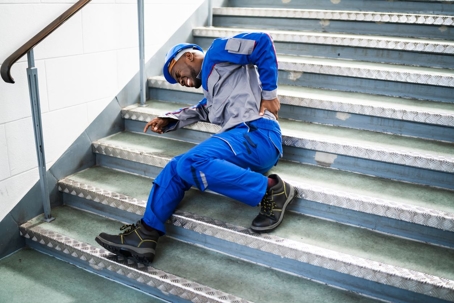Slip and fall injuries often happen when your foot loses traction on a slippery surface. Trip and fall injuries usually occur when your foot collides with an obstacle or uneven ground. Both can lead to fractures, sprains, or head injuries. The key difference lies in how you lose balance, by slipping backward or sideways, or by tripping forward.
At Goldenzweig Law Group, we understand that these differences matter when it comes to proving liability and pursuing compensation. Whether your fall happened in a grocery store, parking lot, or at work, our team is here to help.
Call us today at (713) 561-5003 or visit us at 6575 West Loop South, Suite 420, Bellaire, TX 77401 to schedule your free consultation with attorney Stephen Goldenzweig. Let’s discuss your options and take the first step toward recovery.
What Are Slip and Fall Injuries?
Slip and fall injuries happen when your foot loses traction on a surface. This loss of grip often comes from wet floors, spills, or icy patches. As the foot slides forward or backward, you suddenly lose balance. Common hazards include weather-related threats, like rain, ice, or snow, and indoor risks from unclean or poorly maintained floors. During a slip, the body is often propelled backward or sideways, causing the upper body to whip backward. This movement can result in sprains, fractures, or head injuries.
At Goldenzweig, we focus on preventing these accidents. We offer guidance on spotting potential slip hazards and taking practical steps to stay safe. By addressing wet surfaces, maintaining walkways, and wearing proper footwear, you reduce the chance of serious harm.
What Are Trip and Fall Injuries?
Trip and fall injuries happen when your foot catches on an obstacle or uneven surface. You often pitch forward in these incidents. Common trip hazards include raised edges, cables, clutter, and uneven flooring. Poor visibility can compound these risks and make obstacles harder to see. Unlike a slip, where your foot slides, a trip usually sends your upper body forward.
At Goldenzweig, we pay close attention to these differences. We help clients address potential trip hazards and stay alert to changes in surfaces or lighting.
How Do Slip and Fall vs. Trip and Fall Accidents Differ?
Slips occur due to reduced friction between your foot and the floor. Trips involve sudden interference with your step, like stumbling over an object. Slip victims often fall backward and risk wrist, hip, or head injuries. Trip victims generally fall forward, leading to facial injuries, wrist fractures, or knee trauma.
Both slips and trips can share causes, such as poor lighting or inappropriate footwear. At Goldenzweig, we offer solutions that tackle these shared risk factors, like recommending better lighting or safer shoe choices.
Who Is Most at Risk of Slip or Trip Falls?
Older adults often have balance issues, which heightens their risk. Certain workers, like those in construction, warehousing, or hospitality, face uneven surfaces or cluttered pathways. High-traffic areas also increase the chance of falls, especially when flooring is worn or weather creates slippery conditions.
At Goldenzweig, we believe in shared responsibility. Property owners must maintain safe premises under premises liability laws. Individuals can stay vigilant by scanning walking
What Are the Common Causes of Slip and Fall Accidents?
Slip accidents often involve wet or slick surfaces, think spills in grocery stores or ice in parking lots. Inadequate lighting, lack of warning signs, or improper footwear can also set the stage for a slip. Our team encourages posting “Wet Floor” signs, cleaning up spills fast, and wearing slip-resistant shoes.
What Are the Common Causes of Trip and Fall Accidents?
Trip accidents arise from raised edges, loose cables, cluttered walkways, or broken sidewalks. Poor visibility makes these obstacles harder to spot. Goldenzweig advises regular inspections to keep floors clear and well-lit, reducing trip hazards in both homes and workplaces.
Which Injuries Are Most Common for Slip vs. Trip Falls?
Slips often lead to wrist or hip fractures and head contusions if you fall backward. Trips typically injure knees, faces, or arms when you fall forward and try to brace. Our team sees the subtle differences in injury patterns. We also know how crucial it is to seek medical attention right away.
How Is Liability Determined in Slip or Trip Incidents?
Property owners must keep walkways safe, follow building codes, and post warnings for known hazards. Comparative negligence can reduce a victim’s compensation if personal carelessness contributed to the accident (for example, texting while walking). Goldenzweig helps establish fault by looking at maintenance practices, code compliance, and the injured party’s actions.
What Evidence Is Important for a Slip or Trip Claim?
Clear photos of wet floors, uneven surfaces, or missing signage are vital. Witness statements and official incident reports also help. Medical records link the event to the injury. At Goldenzweig, we guide you on the evidence you need and assist in gathering details as part of a thorough legal strategy.
How Can You Prevent Slip and Trip Accidents?
Proper housekeeping, regular repairs, and good lighting make a difference. Spills should be cleaned quickly, and warning signs posted in wet or slippery areas. Cracked sidewalks and raised edges need prompt fixes. Goldenzweig also recommends choosing footwear with grip to limit the risk of falls in high-risk environments.
What Steps Should You Take After a Slip or Trip Accident?
Why Is Immediate Medical Attention Essential?
Some injuries, like head trauma or internal strains, aren’t always obvious at first. Prompt evaluation can prevent complications. Obtaining records of your treatment creates a critical foundation if you need to file a claim later.
How Do You Document the Scene Effectively?
Take photos or videos of any hazard from multiple angles. Note the date and time. Ask bystanders for statements, and request an incident report if you’re on a commercial property. Goldenzweig advises quick, accurate documentation to support your case.
When Should You Contact an Attorney or Insurance?
Many places enforce strict deadlines for filing claims. Delays can hurt your case. Contacting an attorney early helps you protect your rights. At Goldenzweig, we guide you through insurance paperwork, negotiation, and any legal action. Our aim is to secure fair compensation for your injuries.
What Compensation Can You Seek for Slip vs. Trip Injuries?
Which Damages Are Typically Covered?
Medical bills, lost wages, and pain and suffering are common damages. In serious cases, rehabilitation costs or emotional distress may apply. Courts sometimes grant punitive damages if the property owner showed extreme neglect. Our team at Goldenzweig explores all legal avenues to ensure you receive fair support.
How Does Comparative Negligence Affect a Claim?
If you bear some fault, like ignoring a clear warning sign, you may see a reduction in your award. Courts assess whether you took reasonable care. Goldenzweig reviews these factors carefully to argue for the fullest possible recovery.
Why Are Deadlines and Statutes of Limitations Important?
Each state or jurisdiction sets a filing deadline. Missing this period can end your chance to seek compensation. Our team monitors these timelines, making sure your claims move forward on schedule.
Key Takeaways
Slips stem from loss of traction, while trips stem from hitting an obstacle. Both can cause fractures, sprains, or head injuries. Prevention starts with steady housekeeping, good lighting, and responsible property upkeep. If an accident occurs, swift medical care and solid documentation are essential.
Goldenzweig Law Group is here to support you. From documenting the scene and collecting evidence to negotiating with insurance companies, we guide you every step of the way. Contact attorney Stephen Goldenzweig at (713) 561-5003 or stop by our Bellaire office to start your free case review. Your rights matter. Let us fight to protect them.
Navigation
Related Posts


